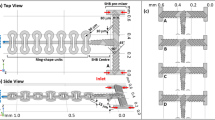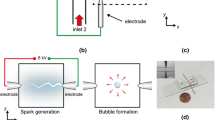Abstract
Due to the low Reynolds number associated with microscale fluid flow, it is difficult to rapidly and homogenously mix two fluids. In this letter, we report a fast and homogenized mixing device through the use of a bubble-based microfluidic structure. This micromixing device worked by trapping air bubbles within the pre-designed grooves on the sidewalls of the channel. When acoustically driven, the membranes (liquid/air interfaces) of these trapped bubbles started to oscillate. The bubble oscillation resulted in a microstreaming phenomenon—strong pressure and velocity fluctuations in the bulk liquid, thus giving rise to fast and homogenized mixing of two side-by-side flowing fluids. The performance of the mixer was characterized by mixing deionized water and ink at different flow rates. The mixing time was measured to be as small as 120 ms.




Similar content being viewed by others
References
Chang CC, Yang RJ (2007) Electrokinetic mixing in microfluidic systems. Microfluid Nanofluid 3:501–525
Chen H, Meiners JC (2004) Topological mixing on a microfluidic chip. Appl Phys Lett 84:2193–2195
Crum LA (1983) The polytropic exponent of gas contained within air bubbles pulsating in liquid. J Acoust Soc Am 73:116–120
Erickson D, Li D (2002) Influencing of surface heterogeneity on electrokinetically driven microfluidic mixing. Langmuir 18:1883–1892
Frommelt T, Kostur M, Wenzel-Schäfer M, Talkner P, Hänggi P, Wixforth A (2008) Microfluidic mixing via acoustically driven chaotic advection. Phys Rev Lett 100:34502
Hellman AN, Rau KR, Yoon HH, Bae S, Palmer JF, Phillips KS, Allbritton NL, Venugopalan V (2007) Laser-induced mixing in microfluidic channel. Anal Chem 79:4484–4492
Ho CM, Tai YC (1998) Micro-electro-mechanical systems (MEMS) and fluid flows. Annu Rev Fluid Mech 30:579–612
Lam YC, Chen X, Yang C (2005) Depthwise averaging approach to cross-stream mixing in a pressure-driven microchannel flow. Microfluid Nanofluid 1:218–226
Law NS, Khoo BC (2002) Transport across a turbulent air–water interface. AIChE J 48:1856–1868
Lee CY, Lee GB, Fu LM, Lee KH, Yang RJ (2004) Electrokinetically driven active micro-mixers utilizing zeta potential variation induced by field effect. J Micromech Microeng 14:1390–1398
Lee YK, Shih C, Tabeling P, Ho CM (2007) Experimental study and nonlinear dynamic analysis of time-periodic micro chaotic mixers. J Fluid Mech 575:425–448
Leighton TG (1994) The acoustic bubble. Academic Press, London
Li D (2008) Encyclopedia of microfluidics and nanofluidics. Springer, Berlin
Lin YC, Chung YC, Wu CY (2007) Mixing enhancement of the passive microfluidic mixer with J-shaped baffles in the tee channel. Biomed Microdevices 9:215–221
Liu RH, Yang J, Pindera MZ, Athavale M, Grodzinski P (2002) Bubble-induced acoustic micromixing. Lab Chip 2:151–157
Mao X, Waldeisen JR, Huang TJ (2007a) “Microfluidic drifting”- implementing three-dimensional hydrodynamic focusing with a single-layer planar microfluidic device. Lab Chip 7:1260–1262
Mao X, Waldeisen JR, Huang TJ (2007b) Hydrodynamically tunable optofluidic cylindrical microlens. Lab Chip 7:1303–1308
Marmottant P, Hilgenfeldt S (2004) A bubble-driven microfluidic transport element for bioengineering. Proc Nat Acad Sci USA 101:9523–9527
Ottino JM, Wiggins S (2004) Designing optimal micromixers. Science 305:485–486
Park HY, Qiu X, Rhoades E, Korlach J, Kwok LW, Zipfel WR, Webb WW, Pollack L (2006) Achieving uniform mixing in a microfluidic device: hydrodynamic focusing prior to mixing. Anal Chem 78:4465–4473
Sannomiya T, Hafner C, Vörös J (2008) In situ sensing of single binding events by localized surface Plasmon resonance. Nanolett 8(10):3450–3455
Shi J, Mao X, Ahmed D, Colletti A, Huang TJ (2008) Focusing microparticles in a microfluidic channel with standing surface acoustic waves (SSAW). Lab Chip 8:221–223
Song H, Ismagilov RF (2003) Millisecond kinetics on a microfluidic chip using nanoliters of reagents. J Am Chem Soc 125:14613–14619
Stroock AD, Dertinger SKW, Ajdari A, Mezic I, Stone HA, Whitesides GM (2002) Chaotic mixers for microchannel. Science 295:647–651
Tho P, Manasseh R, Ooi A (2007) Cavitation microstreaming patterns in single and multiple bubbles systems. J Fluid Mech 576:191–233
Tsai JH, Lin L (2002) Active microfluidic mixer and gas bubble filter driven by thermal bubble micropump. Sens Actuators A 97:665–671
Whitesides GM (2006) The origins and the future of microfluidics. Nature 442:368–373
Wu Z, Li D (2008) Micromixing using induced-charge electrokinetic flow. Electrochim Acta 53:5827–5835
Xia Y, Whitesides GM (1998) Soft lithography. Annu Rev Mater Sci 28:153–184
Yaralioglu GG, Wygant IO, Marentis TC, Khuri-Yakub B (2004) Ultrasonic mixing in microfluidic channels using integrated transducers. Anal Chem 76:3694–3698
Acknowledgments
Authors thank Madineh Sarvestani, Thomas Walker, and Aitan Lawit for helpful discussion and Tristan Tabouillot for assistance in experiments. This research was supported by National Science Foundation (ECCS-0824183 and ECCS-0801922) and the Penn State Center for Nanoscale Science (MRSEC). Components of this work were conducted at the Penn State node of the NSF-funded National Nanotechnology Infrastructure Network.
Author information
Authors and Affiliations
Corresponding author
Electronic supplementary material
Below is the link to the electronic supplementary material.
10404_2009_444_MOESM1_ESM.doc
Fig. S1 The sidewall grooves were filled with fluid (no bubbles were trapped). (a) Laminar flow of deionized water and ink in the absence of acoustic waves. (b) Laminar flow of deionized water and ink in the presence of acoustic waves. (DOC 2607 kb)
10404_2009_444_MOESM2_ESM.mpg
The video shows the bubbles were trapped when deionized water was injected into one inlet at a flow rate of 3 µl/min. As the fluid passed through the pre-designed grooves on the sidewall of the channel, air bubbles were trapped
10404_2009_444_MOESM4_ESM.mpg
The video shows the mixing effect of ink and water as the bubbles were acoustically excited at their natural frequency. Vigorous streaming resulted in homogenous mixing right after the fluids passing the first two bubbles. The combined flow rate was 12 µl/min
Rights and permissions
About this article
Cite this article
Ahmed, D., Mao, X., Juluri, B.K. et al. A fast microfluidic mixer based on acoustically driven sidewall-trapped microbubbles. Microfluid Nanofluid 7, 727–731 (2009). https://doi.org/10.1007/s10404-009-0444-3
Received:
Accepted:
Published:
Issue Date:
DOI: https://doi.org/10.1007/s10404-009-0444-3




